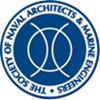Experimental Study of Active T-Foil Control of Longitudinal Motions of a Trimaran Hull in Irregular Waves
IF 1
4区 工程技术
Q3 ENGINEERING, CIVIL
引用次数: 6
Abstract
High-speed ships often experience over larger ship motions in waves. Therefore, highspeed ships without motion control hardly have practical commercial values. Recent years saw wider adoptions of T-foils on high-speed ships, which greatly improve ship performances in waves. In this study, we designed a series of model tests to study the motion-reducing effects of T-foils in waves. Heaves, pitches, and bow accelerations are quantities to be measured in the experimental tests. The study shows that the reduction effects of T-foil-controlled longitudinal motions of a trimaran model are prominent. Comparing with naked model tests, it is found that active T-foil controls may reduce motions of trimaran ships in irregular waves by about 20–30%. In the most favorable case, the reduction is as high as 51%. This study shows that installation of T-foils may dramatically reduce the motions and, thus, provide an efficient control tool to mitigate ship motions in waves. The main aims of the present study were to provide an experimental setup for model testing of an active T-foil control system and determine the control equations. Although the control and actuation systems designed in this study are simple, they do produce the required effects. The model-tested control equations can be used for high-speed foil-type ship design directly if proper similarity ratios are used to project the model test results to real ships. Increasing the length-to-beam ratio is one of the most effective ways to reduce wave-making resistance so that high speed can be achieved (Ackers et al. 1998). High-speed ships with very slender hulls are, however, not stable. Placing two small side hulls on the port and starboard with displacements less than 10% of the total ship displacements improves the ship's stability greatly. This simple consideration led to the fast development of trimaran hull forms in recent years (Coppola & Mandarino 2001; Degiuli et al. 2003; Oh et al. 2005). Encouraged by the successful sea trials of the 127-m-long littoral combat ship Independence at the speed of 50 knots, researchers move forward to search for new technology to improve the motion performances of trimaran hull forms in waves (Li et al. 2002; Hebblewhite et al. 2007; Jia et al. 2009). This is because high-speed ships are faced with the big challenge of severe oscillations in waves. Too large motion responses in waves would counterbalance the high-speed benefits. Therefore, motion control is crucial for high-speed trimaran ships.三体船在不规则波浪中纵向运动的主动T形箔片控制实验研究
高速船舶经常在波浪中经历较大的船舶运动。因此,没有运动控制的高速船舶几乎没有实际的商业价值。近年来,T形翼片在高速船舶上得到了更广泛的应用,极大地提高了船舶在波浪中的性能。在这项研究中,我们设计了一系列模型试验来研究波浪中T形翼片的运动抑制效果。垂度、俯仰和船头加速度是实验测试中要测量的量。研究表明,三体船模型T翼控制纵向运动的减速效果显著。与裸模型试验相比,发现主动T形箔片控制可以将三体船在不规则波浪中的运动减少约20–30%。在最有利的情况下,降幅高达51%。这项研究表明,安装T形翼片可以显著减少运动,从而提供一种有效的控制工具来减轻船舶在波浪中的运动。本研究的主要目的是为主动T形箔片控制系统的模型测试提供一个实验装置,并确定控制方程。尽管本研究中设计的控制和驱动系统很简单,但它们确实产生了所需的效果。如果采用适当的相似率将模型试验结果投影到真实船舶上,则模型试验控制方程可以直接用于高速箔片型船舶的设计。增加长梁比是降低造波阻力以实现高速的最有效方法之一(Ackers等人,1998)。然而,船体非常细长的高速船并不稳定。在左舷和右舷放置两个小船体,其位移小于船舶总位移的10%,大大提高了船舶的稳定性。这种简单的考虑导致了近年来三体船船体形式的快速发展(Coppola&Mandarino 2001;Degiuli等人2003;Oh等人2005)。在127米长的濒海战斗舰“独立”号以50节的速度成功进行海上试验的鼓舞下,研究人员继续寻找新技术来提高三体船在波浪中的运动性能(Li等人,2002;Hebblewhite等人,2007;贾等人,2009)。这是因为高速船舶面临着波浪剧烈振荡的巨大挑战。波浪中过大的运动响应将抵消高速的好处。因此,运动控制对于高速三体船来说至关重要。
本文章由计算机程序翻译,如有差异,请以英文原文为准。
求助全文
约1分钟内获得全文
求助全文
来源期刊

Journal of Ship Research
工程技术-工程:海洋
CiteScore
2.80
自引率
0.00%
发文量
12
审稿时长
6 months
期刊介绍:
Original and Timely technical papers addressing problems of shipyard techniques and production of merchant and naval ships appear in this quarterly publication. Since its inception, the Journal of Ship Production and Design (formerly the Journal of Ship Production) has been a forum for peer-reviewed, professionally edited papers from academic and industry sources. As such, it has influenced the worldwide development of ship production engineering as a fully qualified professional discipline. The expanded scope seeks papers in additional areas, specifically ship design, including design for production, plus other marine technology topics, such as ship operations, shipping economic, and safety. Each issue contains a well-rounded selection of technical papers relevant to marine professionals.
 求助内容:
求助内容: 应助结果提醒方式:
应助结果提醒方式:


